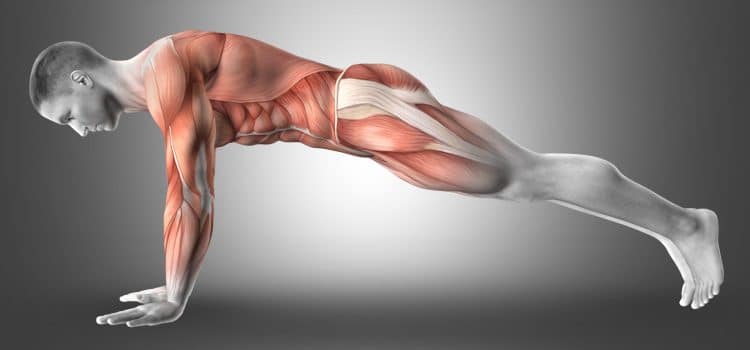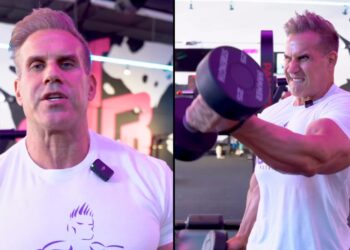You must do things others won’t to get results others can’t. And sometimes, it means doing push-ups — in reverse.
The push-up is one of the most popular bodyweight strength training exercises. They are perfect to be done at home, in the gym, or on the go. Push-ups are convenient and effective; they can help you build strength and muscle mass.
It is a functional movement that improves your upper body strength and musculature and boosts your functionality in daily functioning. The push-up is also one of the first exercises an individual learns to perform.
Push-ups are a part of most training programs. It could be a warm-up exercise, a working set, a pump-inducing finisher, or used to smoke your muscles in a superset.
Like most other things, exercises follow the law of diminishing marginal utility. In weight training, the more of an exercise you perform, the less satisfaction and results you get from each additional set of that exercise.
Adding the reverse push-up to your training regimen is an excellent option for folks who have hit a plateau or want to add variety to their workouts.This article covers everything you need to know about the reverse push-up, including muscles worked, benefits, types, how-to, and common mistakes.
Level Up Your Fitness: Join our 💪 strong community in Fitness Volt Newsletter. Get daily inspiration, expert-backed workouts, nutrition tips, the latest in strength sports, and the support you need to reach your goals. Subscribe for free!
What is a Reverse Push-Up?
The reverse push-up is an upper-body compound (multi-joint) exercise that can help build strength and muscle mass. It can also improve your mobility and flexibility because of its setup. Conventional push-ups primarily target your pecs, whereas reverse push-ups engage the pecs as a secondary muscle.
Per a study, reverse push-ups are incredibly effective at working your abs and back muscles [1]. Make them a part of your calisthenics workouts if you want to work your entire upper body.
The reverse push-up has several variations. Some require you to be supine, while others have you prone. You sometimes maintain your torso and lower legs perpendicular to the floor while your upper legs are parallel. Some variations use equipment like a barbell and squat rack, whereas others use body weight.
As you might have guessed, there is no textbook reverse push-up. Some push-up variations and alternatives are collectively known as the reverse push.
Muscles Worked During Reverse Push-Up
Reverse push-up variations work the following muscle groups:
Triceps
The triceps are the most common primary muscle groups in all reverse push-up variations. Since push-ups involve pushing your body weight against gravity, your triceps will always be in play.
You could train your triceps from different angles in reverse push-ups by changing your hand placement. Switching up your stance will also stimulate all other muscle groups differently.
Deltoids
In reverse push-up variations like the full-body reverse push-up and bench dips, you’ll experience a greater anterior deltoid engagement. Furthermore, push-up variations that require you to be supine will also result in more delt recruitment than the conventional push-up.
The full-body reverse push-up is an excellent variation for exercisers that train at home and want to work on their shoulders. Keep your reps slow, controlled, and deliberate for optimal muscle fiber recruitment.
Biceps
Using an upside down (palms up and fingers facing the wall behind you) hand placement helps better engage your biceps during push-ups. Keep your palms under your shoulder for optimal biceps engagement.
You must ease into the biceps-focused push-ups since they can tax your shoulder and elbow joints. Spend 5-10 minutes warming up your muscles to reduce your risk of injury. Furthermore, perform a few warm-up reverse push-up sets with your fingers facing outward and perpendicular to your torso to loosen up your arms.
Back
The full-body reverse push-up is a great exercise to train your back. Its big range of motion engages almost every muscle fiber in your lower and upper back, helping tone your back and building strength and endurance.
Reverse push-up variations that require you to face away from the floor need you to pull together your scapula, resulting in greater back engagement than conventional push-ups.
Abs
You must keep your core engaged while performing push-ups to maintain a stable upper body. Letting your core loosen can cause your hips to drop and hamper your push-up form, performance, and results.
Chest
Most reverse push-up variations result in chest engagement. The push-up variations where you are prone (facing the floor) will lead to greater pectoral stimulation than the exercises where you are facing the ceiling.
Benefits of Reverse Push-Up
Adding reverse push-ups to your training regimen entails the following benefits:
Build Strength and Muscle Mass
Reverse push-ups are functional upper-body exercises that train multiple muscle groups. They can help build strength and muscle mass in your chest, shoulders, triceps, and back. You must program the exercise in your training regimen as per your objectives.
Perform 1-5 reps if you want to improve your strength. On the flip side, stay in the 8-12 rep range for building muscle mass [2]. Additionally, the reverse push-up can improve your performance in daily activities.
You can make the reverse push-ups more challenging by using a weighted vest or placing a weight plate on your back.
Improve Core Strength
Most reverse push-up variations require pushing your body away from the floor while keeping your upper body braced and stable. Holding your body weight in the static contractions and during the eccentric and concentric motions helps develop core strength.
Level Up Your Fitness: Join our 💪 strong community in Fitness Volt Newsletter. Get daily inspiration, expert-backed workouts, nutrition tips, the latest in strength sports, and the support you need to reach your goals. Subscribe for free!
Enhance Endurance
Unlike the bench press, where lifters usually stick to doing 30 reps (three sets of 10), many exercisers perform a high number of reps on the push-up to achieve a pec-popping pump. Doing 50-100 reps of the push-up in a workout can help build muscle endurance and stamina.
Versatile
Irrespective of your training program and goals, you can make space for the reverse push-up in your training regimen. You can do them in your warm-up routine, mid-workout, as a superset, exhaustion set at the end of your workouts, or as a cool-down exercise.
You could do reverse push-ups in the morning to start your day with a solid pump. Many people like to wrap up their day by doing push-ups. You can do this bodyweight exercise anywhere at any time.
Improves Posture
Push-ups strengthen your upper body muscles, which can help improve your posture by reducing the likelihood of slouching, rounding of the shoulders, and forward head posture. It can help relieve neck, shoulder, and lower back tension.
Furthermore, you must keep your abdominals and lower body engaged to stabilize your body. It can help support the spine and improve overall posture. Reverse push-ups require keeping your spine neutral throughout the exercise, helping improve spinal alignment.
Beginner-Friendly
Despite all its benefits and versatility, the reverse push-up is an easy exercise to perform. Beginners can use this compound exercise to build strength and a solid foundation for their weight training routine.
Types and How To of Reverse Push-Up
Here are the most common reverse push-up exercises and how to perform them with the correct form:
Full-Body Reverse Push-Up
As the name suggests, this is a full-body exercise. Warming up before this exercise will help achieve a better range of motion.
Steps:
- Get into a high plank position with your hands under your shoulders and your feet placed shoulder-width apart.
- Brace your core and glutes. This will be your starting position.
- Lower toward the floor by bending your elbows until your chest is almost an inch away from the floor.
- Pull your shoulder blades together and push your buttocks upward and backward toward your feet, ensuring your knees don’t touch the floor.
- Transfer your weight to your lower body with your arms extended overhead.
- Hold this position for a second.
- Push through the balls of your feet and drive your hips forward to get into the high push-up position.
- Repeat for recommended reps.
Pro Tip: This is a full-body exercise, so you can use it in your HIIT bodyweight workout routines.
Crab Push-Up
The crab hold is a core-building exercise. You can, however, work your shoulders, biceps, chest, and back with this exercise by doing push-ups in this position.
Steps:
- Sit upright on the floor and extend your legs in front of you.
- Bend your knees and place your feet flat on the floor shoulder–width apart.
- Lean back slightly and place your hands under your shoulders. Your fingers should be pointing toward the wall behind you.
- Transfer your weight onto your hands. Lift your hips off the floor by driving through your heels and midfoot.
- Your body should be in a straight line from shoulders to knees in this position.
- Lower your hips toward the floor by bending your elbows. Your hips should be a few inches off the floor at the bottom.
- Drive through your palms to return to the starting position.
Pro Tip: Keep your head upright throughout the exercise. Dropping your head back can put unnecessary strain on your neck.
Inverted Row
The inverted row is the mirror opposite of a push-up as it involves lying supine and pulling your chest toward the ceiling.
Steps:
- Set a Smith machine barbell at waist height. The bar should be so high that it doesn’t touch the floor while you’re holding it, and your arms are fully extended.
- Lie supine under the bar so that your chest is directly under it.
- Grab the bar with a slightly wider-than-shoulder-width grip.
- Lift your upper body off the floor. Your body should be in a straight line from head to heel throughout the exercise.
- Pull your chest to the bar by bending at your elbows.
- Pause and contract your lats at the top.
- Slowly return to the starting position.
- Repeat for recommended reps.
Pro Tip: Make the exercise harder by placing your lower legs on an elevated platform like a bench or a plyo box.
Reverse Hand Push-Up
This is a popular push-up variation that focuses on your biceps. The reverse hand push-up is almost like the traditional push-up, with the only difference being your hand position.
Steps:
- Get into a high plank position with your palms under your shoulders and your fingers facing the wall behind you.
- Lower your chest by bending your elbows until it is a few inches from the floor.
- Pause at the bottom.
- Explode back to the starting position.
- Repeat for recommended reps.
Pro Tip: Avoid locking out your elbows at the top to avoid unnecessary joint stress.
Bench Dips
Bench dips are one of the most popular bodyweight triceps exercises.
Steps:
- Sit sideways on a flat bench.
- Place your hands shoulder-width apart on the edge of the bench.
- Move your feet out until your legs are straight.
- Extend your arms to get in the starting position.
- Lower toward the floor by bending your elbows until your upper arms are parallel to the floor.
- Explode back to the start position.
- Repeat for recommended reps.
Pro Tip: Keep your torso close to the bench for optimal triceps and chest engagement.
Common Mistakes While Performing a Reverse Push-Up
Below are the most common reverse push-up errors:
Not Warming Up
You should warm up before every workout. Loosening up before a training session becomes much more important when you’re doing exercises that require putting your joints, tendons, muscles, and ligaments in unique positions, such as while performing the reverse-hard push-up and crab push-up. Spending 5-10 minutes warming up before each workout can lower your risk of injury while training.
Bracing Your Core
Many people do not keep their cores contracted while performing reverse push-ups, leading to their hips dropping and backs slouching during the exercises. Using a suboptimal form causes you to leave gains on the table.
Incorrect Neck Position
Dropping back your head on tucking in your chin while performing reverse push-ups can sprain your neck. Keep your neck and head neutral with your spine to avoid unnecessary tension.
FAQs
Is the reverse push-up better than the conventional push-up?
The reverse push-ups focus on your triceps, back, shoulders, and biceps, whereas the conventional push-up prioritizes your chest. Each push-up variation deserves a place in your exercise arsenal.
How often should I do the reverse push-up?
You could do reverse push-ups in your triceps or push-day routines. Doing them twice a week, with at least two days of rest in between, provides the right amount of stimulation and time for recovery for optimal growth.
More on Push-ups:
- How Many Push-Ups Should I Be Able to Do?
- Weighted Push-Up Guide
- 11 Push-Up/Pull-Up Workouts for Upper Body
- 12 Reasons To Do Push-Ups Every Day
- Press-Up Vs. Push-Up – What’s the Difference?
- 15 Intense Push-Up Variations for Bodybuilders
Wrapping Up
Reverse push-ups have a more complex range of motion than standard push-ups, and you might need more time to master the exercise. Your effort in learning the lift will pay dividends in the long run as it engages more muscle groups than the standard push-up.
Reverse push-ups can help build upper-body strength, muscle mass, and endurance, improve posture by strengthening the upper back and core muscles, and improve spinal alignment. As you get stronger, you can make these exercises harder by introducing additional resistance by wearing a weighted vest or using weight plates. Best of luck!
References
- Marcolin G, Petrone N, Moro T, Battaglia G, Bianco A, Paoli A. Selective Activation of Shoulder, Trunk, and Arm Muscles: A Comparative Analysis of Different Push-Up Variants. J Athl Train. 2015 Nov;50(11):1126-32. doi: 10.4085/1062-6050-50.9.09. Epub 2015 Oct 21. PMID: 26488636; PMCID: PMC4732391.
- Krzysztofik M, Wilk M, Wojdała G, Gołaś A. Maximizing Muscle Hypertrophy: A Systematic Review of Advanced Resistance Training Techniques and Methods. Int J Environ Res Public Health. 2019 Dec 4;16(24):4897. doi: 10.3390/ijerph16244897. PMID: 31817252; PMCID: PMC6950543.
Interested in measuring your progress? Check out our strength standards for Bench Press, Push Ups, Bench Dips, and more.









